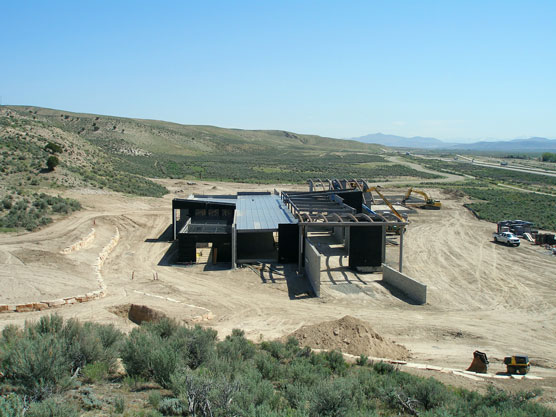|
You are viewing ARCHIVED content published online before January 20, 2025.
Please note that this content is NOT UPDATED, and links may not work. For current information,
visit https://www.nps.gov/aboutus/news/index.htm.

Mike Brown - Elko Field Office, BLM
Contact: Mike Brown, Elko Field Office, BLM, (775) 753-0386 ROOF GOING ON THE CALIFORNIA TRAIL CENTER Elko, Nev. — The California Trail Interpretive Center had a major milestone this week with the start of roof construction. “Glassey Steel Works completed the installation of the barrel (arched) beams, installed the remainder of the “bar-joists,” and began putting on the roof decking,” said Bureau of Land Management (BLM) California Trail Center Manager Dave Jamiel. West Coast Construction constructed the 18” and 24” storm drain and drop inlets at the east parking lot. Spires Concrete Specialties poured concrete: the last of 3 plaza walls and portions of the 7 interpretive walls. Copeland Electric laid conduits in the plaza area for exterior lighting. Kodiak Roofing and a field representative from Epro Waterproofing Systems sprayed the exterior masonry walls with a waterproofing sealer. “The building is really taking shape and people can see the changes and progress every week,” Jamiel added. STORIES FROM THE TRAIL Death on the Humboldt - by Mike Brown Edward Washington McIlhany was 20 years old and lived in Virginia. Wanting to seek his fortune in California and also wanting to forget a love affair gone south, he joined the Charleston, Jefferson County, Virginia, Mining Company. He had to apply to join and pay $300 into the Company’s general fund. They departed Virginia on March 3, 1849 and made their way to St. Joseph, Missouri. In late July at the beginning of the 40-mile desert in Nevada he tells a story of tragedy. “We camped there to rest our mules, to cut hay, and fill our kegs with water to cross the desert. It was a wide pretty valley with fine grass. The mules were turned loose to graze, and a young man by the name of Joe Davis and myself, were put on guard. It was a very hot day. Near where we were there was a large sage bush. The mules were grazing quietly, and he and I got under this sage bush to protect our heads from the sun. We each had our double-barreled shot gun. We were there quite a while talking and noticed that the mules were straying a little too far off. We got up to walk around them. Davis had his gun by the side of him, with the breech towards the bush. He took hold of the barrel of the gun as he got up, and the hammer caught on a little twig on the bush. Down fell the percussion cap and the gun was discharged, the load going into his side just above the hip. I ran out and waved my hat; the boys were near camp, cutting hay and filling the kegs with water. They heard the report of the gun. Quite a number of them came running to where we were. I told the boys that Joe had shot himself. They ran back to camp, got a blanket and a doctor. They returned and packed him to camp on the blanket. He lived but four hours. The doctor could do nothing to save his life.” “It was a sad and distressing sight to see what had happened, but by this time, however, most of the men had schooled themselves to stand everything that happened to them on the plains. We remained in camp the next day. Joe said that he was not afraid to die, but it was so lonely to be buried way out there, and it would grieve his mother nearly to death. He had a brother with him, and he was very much distressed, indeed. He was dressed, sewed up in a blanket and placed in a deep grave. A foot and head board was put to his grave, with his name, date, age and company on it, together with the cause of his death. The burying of one of our comrades on the plains came to some of the men with a very sad and sorrowful feeling. He was the third man we lost from the time we started up to that date.” Edward was successful in California and eventually went home to Virginia where he encountered the former love of his life … but that’s another story. From McIlhany’s Recollections of a '49er. -end- |
Last updated: April 23, 2025
